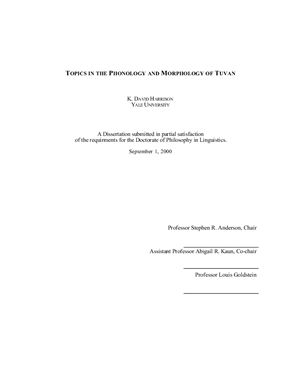Harrison K.D. Topics in the phonology and morphology of Tuvan. -
Yale University, 2001. - 197 p.
This thesis sets out, in some detail, the grammatical structure of the Tuvan language.
Examples given herein are nearly all taken from original data collected by the author during
fieldwork in 1996, 1998, 1999 and 2000. Chapter one provides a general overview of the
grammar, including phonology, morphology and syntax.
Chapter two presents an acoustic study of the unique pitch accent system. We
develop a hypothesis that the phonologically salient feature is pitch contour. Other acoustic
qualities such as quantity are determined, we argue, by the dynamics of producing the right
contour.
Chapter three considers two complex phonologcial processes and their interaction.
First, Tuvan is shown to have a kind of hiatus resolution in which low vowels dominate
regardless of their relative position. This type was previously thought to be rare among the
world’s languages. Second, a process of velar deletion is shown to ‘feed’ hiatus resolution.
Velar deletion is shown to be a robust phonological process, yet one that is blocked in a
non-uniform subset of environments. Blocking of velar deletion arises, we demonstrate, to
enhance recoverability of an identifiable class of ‘small’ morphological elements (i.e. short
stems and short suffixes).
Chapter four discusses the basic pattes of vowel harmony in Tuvan and situates
these in a theoretical model. In chapter five, we explore previously undocumented
reduplication pattes. Further, we show the complex interaction of these with vowel
harmony. The operation of harmony in reduplication yields strong evidence for the
necessity of underspecification in the grammar. We argue that underspecification is a
natural and expected outcome of harmony systems and is not dependent on the presence of
predictable alteations. Rather, it is driven by the presence of pervasive pattes of vowel
occurrence, which may or may not include surface alteations.
In the Summary, we discuss some outstanding problems and suggest areas of
research that might benefit from our discoveries about Tuvan.
This thesis sets out, in some detail, the grammatical structure of the Tuvan language.
Examples given herein are nearly all taken from original data collected by the author during
fieldwork in 1996, 1998, 1999 and 2000. Chapter one provides a general overview of the
grammar, including phonology, morphology and syntax.
Chapter two presents an acoustic study of the unique pitch accent system. We
develop a hypothesis that the phonologically salient feature is pitch contour. Other acoustic
qualities such as quantity are determined, we argue, by the dynamics of producing the right
contour.
Chapter three considers two complex phonologcial processes and their interaction.
First, Tuvan is shown to have a kind of hiatus resolution in which low vowels dominate
regardless of their relative position. This type was previously thought to be rare among the
world’s languages. Second, a process of velar deletion is shown to ‘feed’ hiatus resolution.
Velar deletion is shown to be a robust phonological process, yet one that is blocked in a
non-uniform subset of environments. Blocking of velar deletion arises, we demonstrate, to
enhance recoverability of an identifiable class of ‘small’ morphological elements (i.e. short
stems and short suffixes).
Chapter four discusses the basic pattes of vowel harmony in Tuvan and situates
these in a theoretical model. In chapter five, we explore previously undocumented
reduplication pattes. Further, we show the complex interaction of these with vowel
harmony. The operation of harmony in reduplication yields strong evidence for the
necessity of underspecification in the grammar. We argue that underspecification is a
natural and expected outcome of harmony systems and is not dependent on the presence of
predictable alteations. Rather, it is driven by the presence of pervasive pattes of vowel
occurrence, which may or may not include surface alteations.
In the Summary, we discuss some outstanding problems and suggest areas of
research that might benefit from our discoveries about Tuvan.

